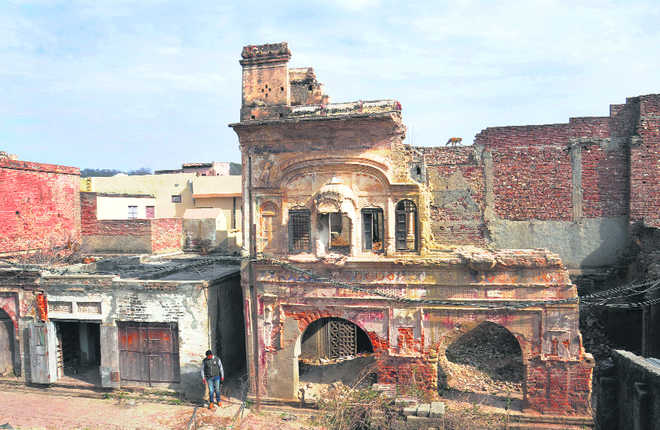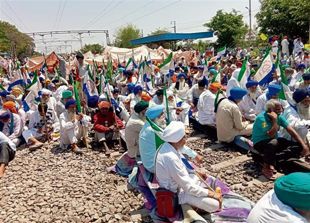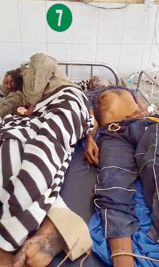
Lost in time: A decaying multi-storey haveli at Jaijon village in Hoshiarpur district.
Aakanksha N Bhardwaj in Hoshiarpur
Mohsin Naqvi would throb in your heart: …is dasht me ik shahar tha, vo kya hua… awargi…ye dil, ye pagal dil mera…(in this barrenness was a town, what befell it.. in wandering! this heart, this mad heart of mine…). Welcome to Patharanwali (a village of stones): Its slide from Jaijon Khas/Jaijon Doaba — a trading hub of the north — has been both historic and heartrending.
In the strange silence of the village of less than 2,000 people, around 80 km from Jalandhar, lies sprawled a deadened bazaar. Here you are: an empty 250-kg galla (a till for keeping cash) with six inbuilt locks is lying in the open; most walls of some of the three-storey shops and havelis have receptacles for keeping lamps to light up the place. These lamps are still there covered in soot, and you can see traces of the black smoke. Almost each shop had a large guest house on the first or second floor for lodging the traders from far-off. That was about a century ago in ‘Jaijon Doaba.’
The decaying multi-storey havelis invite you inside, to the upper floors. But watch it! The crusty, weakened floor can collapse, as it did when this reporter stepped in, resulting in injuries. This is where once existed one of the biggest markets of Asia. The village was known as Pathranwali because the land is full of stones. In its heyday, it became Jaijon Khas, and when it lost its market-worth, it rebounded to the time-scarred Patharanwali. Today, villagers avoid calling it Jaijon: it is believed to be inauspicious.
For the record, Jaijon Doaba is located in Mahilpur sub-division, district Hoshiarpur. Jaijon Khas was a municipal committee in 1950, now it has been reduced to a gram panchayat. Its population in 1950 was around 15,000, which has whittled down to 1,257. Sarpanch Kulwinder Kaur, and panchayat member Parveen Kumar Sandhu go back in time, recalling how ‘special guns’ were placed to sound alarm and warn the traders in case of any attack. In 1917, a rail line reached Jaijon, whose stones were transported to other parts of the country for building rail tracks.
Those stones, and that lost glory get a few residents talking. Rakesh Kumar Jain refers to his ancestors who told him how Jaijon was a bustling, round-the-clock market, whose passages were clogged with customers and camels, horses, ponies carrying goods. For Chaman Lal, the once famous sweets maker, it is hard to begin the Jaijon story. “From where should I start? People back then would not have time to count the money they would make in their businesses.” Lal offers some postcards, priced three pies in 1909, written in Urdu by customers in Lahore, Amritsar, Palampur and paper merchants of Amritsar to the Jaijon Khas addresses. In the early last century, the place supplies goods to every part of united Punjab, J&K and Delhi. The main supplies came from Peshwar, Kota and Lahore.
Ramesh Kumar (81) sits all alone outside his house in a curfew-like surroundings and stares at his closed three-story shop that once sold cloth. “At that time here was not only one, but many markets like the Khanna market, Sood market and Jain market with around 1,000 shops. The place was teeming with customers, coolies, sellers, and commission agents.”
Such was the volume of business that one of the bigwigs of that time paid up to get the rail line extended right up to his godown. The Jaijon Doaba line of Northern Railways was laid in 1917 and goods and passenger trains started, giving a big boost to the trade. Today there is no direct bus from and to major cities of Punjab.
“After the Partition, Muslim workers, artisans and traders went to Pakistan. Camels, horses ponies, bullock carts gave way to motor vehicles. Main roads leading to other towns abandoned Jaijon. The business started shifting to Phagwara, Nawanshahr, Hoshiarpur, and Ludhiana. In these towns, Jaijon-walia-di-hatti is a common name for shops.
Most youth of this village are bachelors. “Who would like to live in an abandoned land?” asks a villager.
Vijay Kumar Sampla, MP, Hoshiarpur and Union minister of state for social welfare, says: “We are in the process of promoting the village by first connecting it to Hoshiarpur and Rupnagar”.
Jaijon awaits that to happen.



























